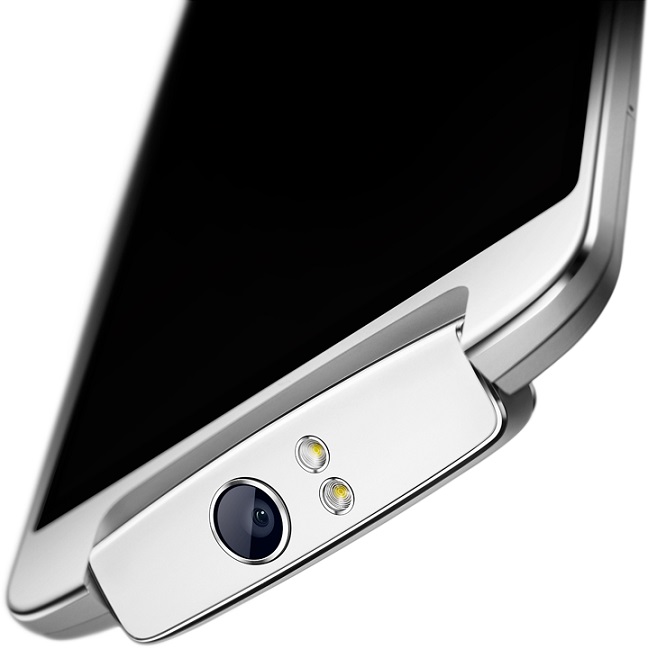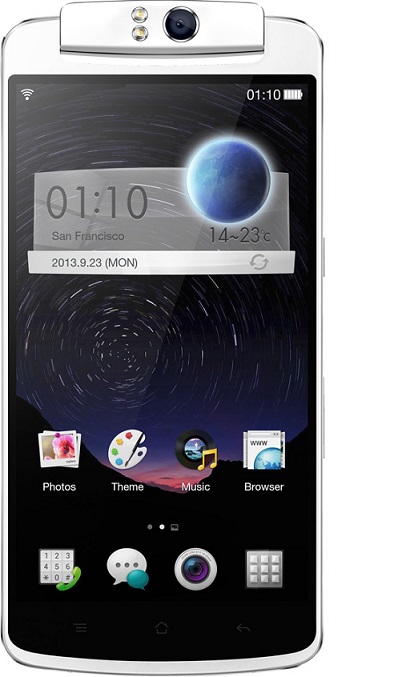Microsoft’s not the only ones busy making big announcements today. Chinese manufacturers Oppo have finally announced the new N1 smartphone, featuring a unique, never before seen swiveling 13MP rear camera – making it the world’s first rotating camera smartphone.
Article continues after the jump.
With its 5.9-inch display, the Oppo N1 – which the company teased as early as August – is firmly in phablet territory. Featuring a Full HD IPS screen, the N1 is powered by a Qualcomm Snapdragon 600 quad-core 1.7GHz processor with 2GB of RAM. It features storage options of either 16GB or 32GB, as well as four sensors: distance, light, G force as well as a 4-directional gyroscope. Rounding up the specs list is a generous 3610mAh battery.
So far, nothing too impressive, no?

That’s when we touch on the camera on the N1. The f2.0 13MP sensor features a six-element lens, similar to those found on the Nokia Lumia 925, Lumia 1020 and the new iPhone 5s. Notice the lack of an Android option? The N1 is the first Android smartphone offering a six-element lens. It also has its own image signal processor (ISP). The Slow Shutter mode on the N1 also allows for long exposure photography, leaving the shutter open for up to 8 seconds. On top of that, the N1 also sports a dual-mode LED flash: one for normal rear-facing shots, and another diffused softer flash for front-facing pictures. The brightness of the dual-mode flash is also customisable via the N1 camera software.
On to the party piece of the N1. The upper portion of the N1 containing the camera sensor and flash can be swiveled up to 206 degrees. The result of over a year of development, the rotating mechanism also locks in any angle, and has been tested to rotate over 100,000 times – 7 years of usage if you rotate it 40 times a day.
On top of that, the Oppo N1 also sports what it calls the O Touch Panel: a 12cm² touch panel at the back of the N1. The O Touch panel supports gestures such as sliding (in all four directions), tapping, double tapping as well as long-pressing. All these gestures work as if you are doing the gestures on the display itself, without blocking the display. It is also claimed to aid one-handed usage of the phablet.
Another interesting fact of the Oppo N1 is in its operating system. Unlike other mainstream Android manufacturers, Oppo is shipping the N1 with Color OS, developed by Oppo and based on Android 4.2. In addition, the bootloader will ship unlocked, while there will be an option to flash to the popular CyanogenMod ROM. Oppo will also ship a limited edition N1 CyanogenMod Edition, shipping with CyanogenMod pre-installed, making it the world’s first CyanogenMod hardware.
Finally, there is the O-Click. A Bluetooth accessory to the N1, it acts both as a remote camera trigger as well as a device locator. Utilising Bluetooth LE, the O-Click has a connection range of up to 50 meters.
The Oppo N1 will be available in early December from CN¥3,498 (around RM1790). International availability remains a mystery, though Oppo has been making its Find 5 smartphone available internationally the last time out.
Follow us on Instagram, Facebook, Twitter or Telegram for more updates and breaking news.





